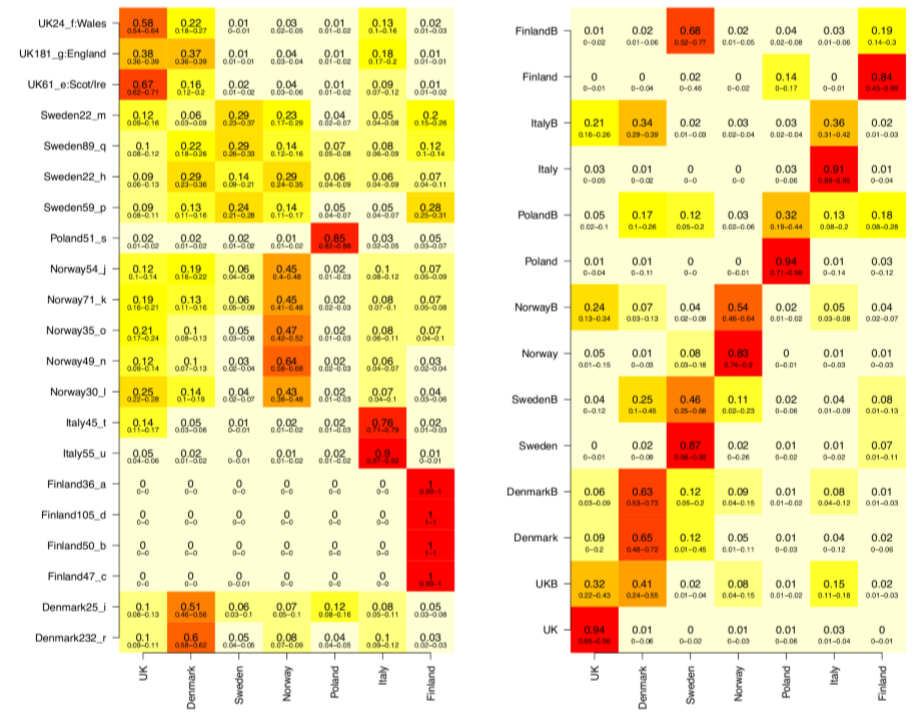0
















| Thumbs Up |
| Received: 72 Given: 1,261 |

Do your ‘niggling doubts’ concern the possibility that this component existed prior to the Medieval period, but the reason for it being negligible in Wales is down to it being more ‘isolated’ (genetic drift). England, being less isolated, was able to witness less genetic drift as a result and thus this ‘French’ component ‘remained’? I am sorry if that sounds retarded.

















| Thumbs Up |
| Received: 14,030 Given: 6,627 |

So you think Saxons who migrated to Britain were largely or even mostly mixed Celto-Germanic already? I wouldn't discount that.
What about the Angles? It's quite strange that East Anglia (and other Anglian areas) had almost no France IA ancestry in Early Medieval times, but today East Anglia has more France IA ancestry than any other region. And we know from the recent Cambridgeshire Black Death study that by the mid 14th century East Anglians were genetically similar to today.
Spoiler!

















| Thumbs Up |
| Received: 14,030 Given: 6,627 |

I don't entirely take it at face value. Lack of samples misrepresents reality in many studies. In the Margaryan Viking study from 2020 England was modelled as having 38% ancient British ancestry ('North Atlantic'), but also with 18% Italian-like ancestry. I am sure this was due to the lack of ancient French ancestry in that model, that would take away that faux Italian ancestry and likely some of the British-like ancestry too.

Spoiler!

















| Thumbs Up |
| Received: 14,030 Given: 6,627 |

My niggling doubt is that the 367 year-long Roman colonisation (and the Belgae influence before it) left apparently no real genetic impact on Southern Britain. Meanwhile Hengist and Horsa's lot, a few boatloads of scruffy Saxon mercenaries, ended up replacing a population of millions to the tune of 75% in a few centuries
Spoiler!














| Thumbs Up |
| Received: 72 Given: 1,261 |

One must reiterate how interesting it is that Cornwall is far more ‘English’ than South Pembrokeshire even though the latter has been far more culturally aligned to England (like a cultural enclave within Wales) than the former. Also, whilst there is no denying that the NE of England is definitely far more ‘Brythonic’ than central/southern England, one would still think of Cumbria or Shropshire/Herefordshire as being the most to have this admixture. There is no way that it can bear a negligible difference to Cumbria. It’s common knowledge that whilst the kingdom of Northumbria was at its zenith, Cumbria existed as the southern portion of the Brythonic kingdom of Strathclyde. It also can’t be if it is indeed the ‘blondest’ part of England (although I thought that was Yorkshire). At the very least you would assume it to be equidistant between Cumbria and Yorkshire? I would also have imagined the SE of Scotland to be less Brythonic than Cumbria as well. Maybe the sample size was small from said region.
And why do you think the ‘French’ admixture supersedes or is equal to Anglo-Saxon admixture in Cornwall and South Pembrokeshire when in England (aside from Suffolk and Norfolk), the Anglo-Saxon admixture comfortably supersedes the ‘French’.














| Thumbs Up |
| Received: 72 Given: 1,261 |

Considering that South Pembrokeshire is ‘historically’ the most English part of Wales, we can’t imagine much of the rest of the south of the country being any less Brythonic surely. It likely no disappeared once you get to the border. Until about 1800, Monmouthshire (right on the border) was still firmly in Welsh speaking territory. Offa’s Dyke also wasn’t built for no reason. I don’t think there would have been many of the relatively scarce numbers of Anglo-Saxons who made it to Shropshire/Herefordshire who would have been enthusiastic about venturing further west into the hills of ‘barbarians’. Offa of Mercia literally built the dyke as a bulwark against what he saw as the Brythonic speaking ‘barbarians’ were prone to raiding the farmsteads of his citizenry.

















| Thumbs Up |
| Received: 14,030 Given: 6,627 |

What can I say, population genetics is sometimes surprising.
I may have misremembered NE England as being the blondest region, mixing it up with light hair+eyes percentages. Either way it is one of the fairer-haired parts of England, and you may be surprised from Beddoe's 19th century stats that Cumbria was one of the fairest-haired counties.
Don't forget the Norse influence in the Northwest, including Norwegians.
At a guess, because the colonisation of Cornwall and Wales after 1066 was led by Normans, rather than the English per se. South Pembrokeshire was famously populated by Flemings from England rather than Englishmen, perhaps they were the majority of the 'English' that made up Little England beyond Wales. And it's fair to assume that Flanders is more Gaulish/CWE than Germanic/CNE, if East Anglia is anything to go by.
Last edited by Creoda; 03-24-2024 at 02:57 AM.
Spoiler!
There are currently 1 users browsing this thread. (0 members and 1 guests)
Bookmarks